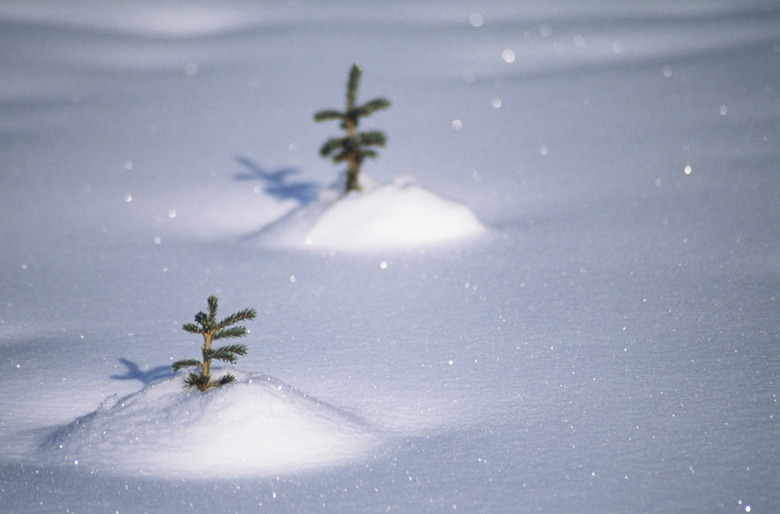Do Small Pine Trees Need To Be Taken Indoors During Winter Time?
Small pine trees (Pinus spp.) make charming, low-maintenance and family-friendly additions to rock gardens, native gardens or naturalized woodland yards. During the winter holidays, many families enjoy decorating small pines with strings of popcorn and cranberries and other bird treats. Larger pines work well as hedge plants, windbreaks or screens and specimen trees on sprawling landscapes, but they start out small. Although small pines may be more drought-tolerant once established, they tend to be just as cold-hardy as their larger cousins sharing the same U.S. Department of Agriculture plant hardiness zones.
A Pine for Every Zone -- Almost
Step 1
Pines are cold-hardy in USDA zones 2 through 13. While 40- to 60-foot Austrian pine (Pinus nigra) is hardy in USDA zones 4 through 7, eastern white pine (Pinus strobus), native to Canada and the United States, is hardy in USDA zones 3 through 8. The dwarf mountain pine known as mugo pine (Pinus mugo) is cold-hardy from USDA zones 2 through 7, while in the Southwest, the Afghan pine (Pinus eldarica), also known as desert pine, grows to 30 to 50 feet in USDA zones 10 through 13.
- Small pine trees (Pinus spp.)
- While 40- to 60-foot Austrian pine (Pinus nigra) is hardy in USDA zones 4 through 7, eastern white pine (Pinus strobus), native to Canada and the United States, is hardy in USDA zones 3 through 8.
Climate Considerations
Step 1
Pine trees are generally very cold hardy. Seedlings from nurseries are often stored between 32 and 36 degrees Fahrenheit to keep them dormant during transport to other nurseries or garden stores. Even bare-root trees, such as ones sold at nurseries that have removed all the soil from their roots, can be stored at such temperatures for up to 8 weeks. Assuming you are growing potted pine trees or seedlings within their proper USDA zone ranges, you probably don't need to bring potted pines indoors or cover others in winter unless there is an unusually frigid cold spell not accounted for in the USDA zone's temperatures.
Protection from the Bite of Frost
Step 1
The key to preventing freeze or frost damage in small pines, especially if they are in containers, is to only grow them within their hardiness zones. Below its hardiness zone, a young pine — or even an established one — has a chance of suffering damage or even dying. If you are growing pines in containers, make sure they are thoroughly watered. Parched plants react much more strongly to freezing temperatures because the cold dries out and withers their foliage. If you live in a warm area and want your plants to be cold-hardy come winter so they are not shocked, buy pre-chilled seedlings. Do not plant during a hard freeze.
- Pine trees are generally very cold hardy.
- The key to preventing freeze or frost damage in small pines, especially if they are in containers, is to only grow them within their hardiness zones.
Keeping Pines Happy
Step 1
Generally, pines are very tolerant plants. They like sites with full sun and prefer not to compete for light or water. Although they will grow in a wide range of soil types, they prefer well-drained soil and moderate moisture. When older, pines tolerate some drought, but small pine trees need consistent moisture to help them withstand the stress of both cold and hot temperatures.
